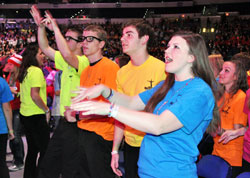NCYC participants encouraged to connect with Christ

Young people enjoy music as they prepare for the Nov. 18 evening session at the National Catholic Youth Conference in Indianapolis. (Photo by Sean Gallagher)
By Sean Gallagher
The 23,000 National Catholic Youth Conference (NCYC) participants who gathered at Lucas Oil Stadium on the evening of Nov. 18 were encouraged to connect with Christ, each other and their own identity.
That encouragement happened from the very start when the attendees made their way into the stadium, and were met by smiling youths holding up signs that read, “Free hugs.” Many took up their offer.
Trying to raise her voice over the loud music that echoed in the stadium, teenager Pickett Lee of Jefferson City, Mo., gave a simple explanation for why she was offering free hugs—“Because God is love!”
Sophia Ess, a youth from Adel, Iowa, gave her own thoughtful answer.
“It increases fellowship and it shows everybody that there is somebody out there who really loves you,” she said.
The three speakers for the evening expanded upon the theme during their presentations.
Christina Lamas-Lujan, San Gabriel regional coordinator of the Office of Religious Education for the Archdiocese of Los Angeles, told listeners how a young woman from Nigeria named Patricia taught her how to connect with Christ.
Lamas-Lujan met her during a 2008 Catholic Relief Services trip to Nigeria. Three months later, Patricia visited Lamas-Lujan in Los Angeles.
“When she was at my house, she taught all of us who interacted with her that Christ is present in every single moment of our lives,” Lamas-Lujan said. “When we are desperately in need of Christ, Christ is there. In our joys, Christ is there. When we have nothing, Christ is there.
“My brothers and sisters, my question to you is, ‘Have you seen the connection? Are you connected to Christ?’ ”
Singer, songwriter and speaker Joia Farmer of Wyoming told the young people to make connections with Christ, each other and themselves. She shared the story of her daughter, Ava, whom she and her husband, Brad, adopted from an orphanage in China.
Ava’s birth mother left her on a bench in front of the orphanage when the baby was a week old. Soon thereafter, an old man walking past noticed the baby and took her into the orphanage.
“You might think that her mother abandoned her,” Farmer said. “I have a different way of seeing abandoned. Some people see it as bad. But in that instance, her mother was my hero.”
Contemplating that action taken by Ava’s birth mother led Farmer to realize that she, too, knows what it means to be abandoned and adopted.
“I felt like an orphan at times,” she said. “I felt that I was not connecting with Christ. I was not connecting with God. I felt that he had abandoned me.”
Farmer noted that Christ on the Cross knew what it was like to be abandoned by his friends—but not by his mother.
“He gave us to her,” Farmer said. “And that is a moment worth noting. We are all orphans. We have all been adopted. In fact, [the night] before Jesus died, he said, ‘I will not leave you orphans. I will come to you’ (Jn 14:18).
“My brothers and sisters, he comes to you. In your time of need, in your time of sorrow, when you think that he’s not there, that he’s abandoned you, he is in that moment, that moment of your weakness.”
Farmer explained that we connect to God when we do his will for us and give loving service to other people.
“My brothers and sisters, love is a verb,” she said. “It is an action. It is loving other people in our lives whom we can’t stand or maybe we’ve been hurt by or who need us. That is an action. It is a verb.”
The final speaker, Bishop Luis Raphael Zarama, was born and raised in Colombia before emigrating to the U.S.
He told participants that, as a youth, he resisted his mother’s call to participate in a retreat. He had even prayed that the bus he was traveling on to attend it would break down so that he could go back home.
“When I reached that place, I cried for two days,” said Bishop Zarama, an auxiliary bishop of the Archdiocese of Atlanta. “I didn’t eat because the food was awful. But, at the end of the third day, through the intercession of Mary, I made my first confession in six years.
“Now, because of my mom, you have a bishop here who loves you.”
Referring to the friends that many young people have on the Internet social media website Facebook, Bishop Zarama encouraged them to consider the quality of their friendship with Christ.
“Where is Jesus in all of the friends?” he asked. “Does he have a space in your life? Do you have time for him? You have time for 10,000 friends all around the world, but when do you have time for Jesus?
“That is the challenge. Connect with Jesus.”
The Friday evening general session ended with participants praying an ancient prayer form called lectio divina—holy reading.
They listened to a Scripture passage, proclaimed, meditated upon it and prayed a decade of the rosary.
NCYC animators proclaimed and acted out the passage, which was the Annunciation of the Blessed Virgin Mary (Lk 1:26-38).
They then meditated upon the passage with the assistance of sand artist Joe Castillo, who created images from the life of Christ that could be seen throughout the stadium on big screens above its stage.
One of the last steps of the lectio divina was contemplation. It turned the cavernous stadium that, just minutes earlier, boomed with loud worship and praise music into a silent house of prayer for about five minutes. †
See all our NCYC coverage here
